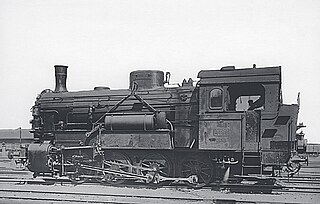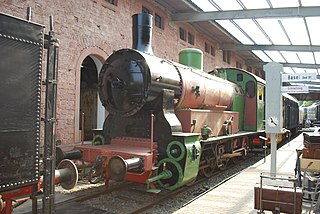This article relies largely or entirely on a single source .(December 2022) |
| Palatine G 1I | |||||||||||||||||||||||||||||||||||||||||||||||||||||||||||
|---|---|---|---|---|---|---|---|---|---|---|---|---|---|---|---|---|---|---|---|---|---|---|---|---|---|---|---|---|---|---|---|---|---|---|---|---|---|---|---|---|---|---|---|---|---|---|---|---|---|---|---|---|---|---|---|---|---|---|---|
| |||||||||||||||||||||||||||||||||||||||||||||||||||||||||||
| |||||||||||||||||||||||||||||||||||||||||||||||||||||||||||
| |||||||||||||||||||||||||||||||||||||||||||||||||||||||||||
| |||||||||||||||||||||||||||||||||||||||||||||||||||||||||||
The Palatine Class G 1I steam locomotives were goods train engines belonging to the Palatine Railways.
This article relies largely or entirely on a single source .(December 2022) |
| Palatine G 1I | |||||||||||||||||||||||||||||||||||||||||||||||||||||||||||
|---|---|---|---|---|---|---|---|---|---|---|---|---|---|---|---|---|---|---|---|---|---|---|---|---|---|---|---|---|---|---|---|---|---|---|---|---|---|---|---|---|---|---|---|---|---|---|---|---|---|---|---|---|---|---|---|---|---|---|---|
| |||||||||||||||||||||||||||||||||||||||||||||||||||||||||||
| |||||||||||||||||||||||||||||||||||||||||||||||||||||||||||
| |||||||||||||||||||||||||||||||||||||||||||||||||||||||||||
| |||||||||||||||||||||||||||||||||||||||||||||||||||||||||||
The Palatine Class G 1I steam locomotives were goods train engines belonging to the Palatine Railways.
These engines were the first Type Hall unites built by Maffei. In addition they had an eccentric crank of the Hall type. This was partly external and partly internal, a feature of engines in Bavaria and the Palatinate. The boiler was entirely dome-less and had a semi-circular outer firebox above. They were equipped with Type 3 T 6 tenders. [1]

The Bavarian Class D XII steam locomotives were manufactured by the firm of Krauss from 1897 for the Royal Bavarian State Railways. Ninety six of them were procured for service on the stub lines running from Munich into the mountains, but in reality they were stationed in many large Bavarian locomotive depots. Two engines were transferred to the Palatinate Railway (Pfalzbahn) in 1916, the remaining 94 later joined the Deutsche Reichsbahn fleet and were incorporated as DRG Class 73.0-1 with operating numbers 73 031–124.

The physically identical Palatine and Bavarian Class R 4/4 engines of the Royal Bavarian State Railways were goods train tank locomotives with four coupled axles and no carrying axles. The first nine machines were built for the Palatinate Railway (Pfalzbahn) in 1913 and 1915 as the Palatine Class R 4, the remainder from 1918 to 1925 as Bavarian R 4/4 engines.

The six-coupled P 5 of the Palatinate Railway (Pfalzbahn) was to replace the four-coupled locomotives in the Palatinate. They were given a leading Krauss-Helmholtz bogie and a trailing bogie in order to achieve satisfactory weight distribution.
The Class S 2/5 express locomotives of the Royal Bavarian State Railways were the first steam engines in Germany to be built with full-length bar frames. The prototypes for this type of frame were the two locomotives imported in 1900 from Baldwin Locomotive Works in the US, that had been similarly classified as the S 2/5.

Class T 5 of the Palatinate Railway was a German, goods train, tank locomotive class with five coupled axles and no carrying axles.

The Palatine Class L 2 were a group of steam locomotives used on the Palatinate Railway in early 20th century Bavaria. They were built for the line between Speyer and Neustadt an der Weinstrasse. Because the engines were to be used double-headed, they had doors on the front and rear of the driver's cabs and an opening in the running plate. This enabled access to the locomotive from the train whilst running.
The German steam locomotive of Palatine Class Pts 2/2 of the Palatinate Railway was a one-off and was built by the firm of Maffei in Munich. Notable features were the high boiler and the locomotive frame used as a water tank. Coal was carried in two bunkers on the left and right of the driver's cab.
The DRG Class 99.10, formerly the Palatine Class Pts 3/3 H of the Palatinate Railway, was a German narrow gauge steam locomotive. It was the superheated version of the PtS 3/3 N. Unlike the saturated steam version the upper section of these engines was no longer glazed, otherwise they were broadly identical. They could carry up to 2.0 m3 of water and 1.2 t of coal.
The narrow gauge steam locomotives of Palatine L 1 and Pts 3/3 N of the Palatinate Railway were procured for lines in the area of Ludwigshafen, Neustadt an der Weinstrasse and Speyer. On the formation of the Reichsbahn the engines were given the running numbers 99 081 to 99 093.

The German steam locomotives of Palatine Class P 3I were operated by the Palatinate Railway and were the first engines in Germany with a 4-4-2 (Atlantic) wheel arrangement. The two-cylinder saturated steam locomotives with inside cylinders had in addition to an inside bar frame a characteristic outer frame for the rear part of the locomotive, that partly covered the driving wheels. The valve gear was of the Joy type.
Richard Wilhelm Ferdinand von Helmholtz was a German engineer and designer of steam locomotives. Richard von Helmholtz was born on 28 September 1852 in Königsberg, Prussia, the son of the physicist Hermann von Helmholtz and his first wife Olga, née von Velten.

The Prussian Class T 12 were early German passenger tank locomotives built for the Prussian state railways in large numbers. These locomotives were superheated variants of the T 11.
The Palatine T 4II was a class of saturated steam, tank locomotives operated by the Palatinate Railway.
The locomotives of Palatine Class T 4I were saturated steam tank engines operated by the Palatinate Railway. Krauss delivered four of them in 1895 and a further three in 1897. The development of these engines had been based on the second batch of Bavarian D VIII engines and they differed only in a few dimensions: for example, the diameter of the carrying and coupled wheels was smaller. In addition they had a larger coal tank.

Neustadt (Weinstr) Hauptbahnhof – called Neustadt a/d. Haardt until 1935 and from 1945 until 1950 – is the central station of in the city of Neustadt in the German state of Rhineland-Palatinate. In addition to the Hauptbahnhof, Rhine-Neckar S-Bahn services stop at Neustadt (Weinstr) Böbig halt (Haltepunkt). Mußbach station and Neustadt (Weinstr) halt, opened on 19 November 2013, are also located in Neustadt.

The Class P 4 steam locomotives of the Palatine Railways were express train locomotives with a 2′B1′ (Atlantic) axle arrangement and a four-cylinder compound engine. A total of eleven locomotives were built by Maffei, numbers 286–291 in 1905 and 302–305 and 133 in 1906. They replaced the P 3.1 in express train service.

The Palatine Nos. 26 to 63 were steam locomotives of the Palatine Railways (Pfalzbahn) and typical express train, tender locomotives of the Crampton type with wheel arrangement 2A. Both running axles were housed in the main frame, the driving axle was behind the vertical boiler. This enabled driving wheels with a diameter of 1,830 mm to be fitted without placing the boiler higher than was customary at the time. As a further feature, the locomotive number 28 Pfalz ("Palatinate") had weather protection for the engine driver and fireman, which was not common at the time.
The Palatine T 3 was a class of goods train tank locomotives with a C n2t wheel arrangement in service with the Palatinate Railway. They had no running axles. They were incorporated into the Deutsche Reichsbahn as DRG Class 891 with operating numbers 89 101–121. Their design was based on that of the Bavarian D V.
The Palatine G 3/3 was a steam-driven, goods train, tender locomotive on the Palatinate network of the Royal Bavarian State Railways.